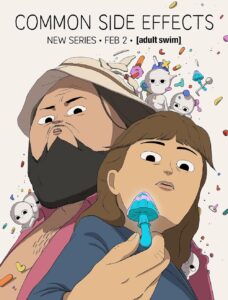


Common Side Effects, Adult Swim’s new original series about a cure-all mushroom, has proved to be a surprising hit. It was renewed for a second season on the day of the season one finale. How did this quirky series succeed when many recent Adult Swim originals have come and gone without fanfare?

Common Side Effects occupies a unique niche in Adult Swim’s library. Common Side Effects’ genre has often been described as thriller, a genre usually used to categorize feature films by directors like Alfred Hitchcock, more than TV animation. Adult Swim originated as one block, airing original comedies parodying Hanna Barbara classics like Harvey Birdman: Attorney at Law, cancelled network comedies like Home Movies and Baby Blues, and anime like Cowboy Bebop. Within six months after Adult Swim’s September 2001 launch, we saw a Saturday Adult Swim develop to focus on action, especially anime, and a Sunday Adult Swim to focus on comedies. Common Side Effects began on Sundays, but a month later, the series began airing from the start on Toonami on Saturdays as well. This type of series is a risky endeavor for Adult Swim. Cartoons that aren’t neatly categorized as action or comedy risk failing to find an audience. On Sundays, it felt somewhat out of place as it was not primarily a comedy. On Saturdays its western animation style and lack of fight scenes contrasts with the rest of the block’s anime.
Our main character, Marshall, has found these mushrooms growing in factory runoff, along with a tortoise named Socrates. Throughout the series Marshall operates as a sort of outlaw shaman, dispensing the mushrooms to the sick as the Drug Enforcement Agency and pharmaceutical companies pursue him. His love interest, Frances, is his high school lab partner. Frances is torn between her job at a drug company and her admiration for Marshall’s idealistic plans to distribute the drug to the world for free. Her boss Rick, who sounds very much like Tom Anderson and Hank Hill, is often playing games on his phone and demanding Frances carry out menial tasks like changing the channel from pay per view content on a hotel television. Desiring to make it big healing the world, including her mother’s dementia, Frances gets caught up in Marshall’s world of espionage and betrayal.
 Many Adult Swim series have mixed reception due to cheap looking animation. Common Side Effects’ designs are divisive, but overall the series is easier on the eyes compared to other recent originals like Royal Crackers. The psychedelic mushroom healing sequences are fluid and colorful. When characters ingest the Blue Angel mushroom, we get to see inside their minds as they come back from near death experiences through the machinations of Ghibli style clockwork elves. The use of the mushrooms is not always beneficial, however. One character’s attempt to consume large quantities in a frenzy backfires on him.
Many Adult Swim series have mixed reception due to cheap looking animation. Common Side Effects’ designs are divisive, but overall the series is easier on the eyes compared to other recent originals like Royal Crackers. The psychedelic mushroom healing sequences are fluid and colorful. When characters ingest the Blue Angel mushroom, we get to see inside their minds as they come back from near death experiences through the machinations of Ghibli style clockwork elves. The use of the mushrooms is not always beneficial, however. One character’s attempt to consume large quantities in a frenzy backfires on him.
What makes this series compelling is the realistic characterization and interaction. Even Rick, who initially seems to be hopelessly irredeemable, does show he has a heart when he realizes the magnitude of the mushrooms’ healing potential. Frances is torn between a stabile life with her Virtual Reality gaming addicted fiancé Nick, and a life of adventure and romance, curing the sick with Marshall. Marshall is forced into uneasy partnerships with sketchy people like his veterinarian brother Zane and his eccentric mentor Hildy. The DEA agents pursuing Marshall, who could have easily been portrayed as ruthless and unsympathetic, are even likable. Agent Copano’s conspiracy suspicions position him as a potential ally for Marshall in a second season, pitting Copano against his former partner Harrington.
Are you looking forward to the second season of Common Side Effects?
Discuss this article on the ToonZone Forums.
The post Review: “Common Side Effects”: A Super Effective Thriller appeared first on Anime Superhero News.